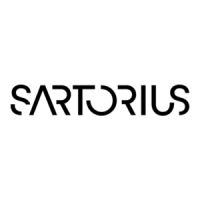Do you have a question about the Sartorius BP121S and is the answer not in the manual?
Details on warranty registration and its importance for user benefits.
Guidelines for allowable storage temperatures and safe transport packaging.
Recommendations for choosing a suitable location and environment for balance setup.
Instructions for connecting the balance unit to its electronics box.
Steps for assembling the weighing chamber with draft shields.
Information on selecting the correct voltage for the balance.
Safety guidelines for using the AC adapter and data interface.
Details on potential radio frequency interference and FCC compliance.
Important safety note on unplugging balance before connecting peripherals.
Advice on handling static electricity interference during weighing.
Requirement for the balance to warm up for accurate results.
How to turn the display on/off and understand the self-test process.
Procedure for zeroing the weight display to determine accurate weights.
How to determine the weight of a sample by placing it on the weighing pan.
Steps for performing internal calibration using the balance's built-in weight.
Procedure for external calibration using external calibration weights.
How to access settings by unlocking the menu access switch.
Procedure for testing the calibration status of the balance.
Information on connecting devices to the balance's interface port.
Instructions for performing weighing operations below the balance.
How to attach an antitheft locking device to the balance.
Information on regular servicing by Sartorius technicians for accuracy.
Guidelines for safely cleaning the balance and its components.
How to select and set menu codes to configure balance functions.
Step-by-step guide to accessing and navigating the balance operating menu.
How to confirm and store a selected menu code setting.
Configuring balance settings based on ambient environmental conditions.
Selecting weighing modes to optimize performance for different weighing tasks.
Defining when the balance performs the taring operation.
Activating the auto zero function for automatic taring of minor fluctuations.
How to toggle between two different weight units for measurement.
Listing and conversion factors for various weight units supported by the balance.
Configuring parameters for data output, including print-on-request and auto-print.
How to start and stop the automatic data output function.
Setting for automatic taring during print-on-request data output.
Explanation of data ID codes used for identifying weighing results.
Defining the function of the menu access switch for balance operation.
How to block all balance keys except for the power/standby key.
Connecting an external switch for remote control of balance functions.
Configuring the balance's power-on behavior (standby or automatic).
Using the tare memory function to store tare weights.
A practical example demonstrating tare, net, and gross weight measurements.
How to change and store the reference percentage for weighing applications.
Setting display parameters for readouts in percent, including decimal places.
How to change and store the reference sample quantity for counting.
Selecting manual or automatic start modes for animal weighing.
Overview of connecting Sartorius balances to computers or peripheral devices.
Notes on electrical connections and potential interference when interfacing devices.
List and explanation of control commands using upper-case letters.
Commands for adapting the balance to different ambient conditions.
Explanation of data communication via interface and parameter matching.
Details on balance interface handshake parameters and protocols.
How to activate data output via software command or pressing a key.
Setting up automatic data output at defined intervals or upon balance startup.
Details on the 'New Installation' service package including installation and training.
Information on the validity of verification and applicable national regulations.
| Maximum Capacity | 120 g |
|---|---|
| Readability | 0.1 mg |
| Calibration | External |
| Display | LCD |
| Linearity | ±0.2 mg |
| Weighing Technology | Electromagnetic force compensation |
| Power Supply | AC adapter |
| Repeatability | 0.1 mg |
| Interface | RS232 |
| Operating Temperature | 10°C to 40°C |











